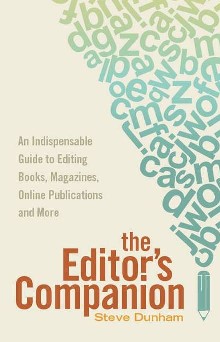Steve Dunham’s Trains of Thought
Return to the home page
The Editor’s Companion
My book, The Editor’s Companion from Penguin Random House (originally published by Writer’s Digest Books in 2014)—a friendly, helpful guide to the principles of editing. I hope it will be useful to journalism students, novice editors, and those who have editing thrust upon them—volunteers editing organizations’ newsletters and websites, or people whose employers have assigned them editing responsibility because they are good with English—as well as lone editors in an alligator pond of co-workers and bosses who have their own ideas about how to punctuate and capitalize things.
Read a review of The Editor’s Companion on the Worlds of R. A. Hortz website.
Read Liz Dexter’s interview with Steve (on her blog).
Read Liz Dexter’s review of The Editor’s Companion .
Read Sue Archer’s review of The Editor’s Companion in Editors’ Weekly .
Watch a half-hour interview with Steve about editing careers on Todd Sullivan’s YouTube channel, posted Aug. 18, 2021.
I also have the Editor’s Companion blog . The newest post: Unhappy medium: will the text be legible when it’s published? (Nov. 1, 2025).
Templates
Two Microsoft Word templates with styles based on “no style” for help with combining documents (please see the July 29, 2017, Editor’s Companion blog post on this topic).
Styles-based-on-No-Style.dotx
Styles-based-on-No-Style.dot
Book Contents
Preface
Editing—who needs it?
Introduction
Editors help writers to get their work published, to communicate
with their readers, and to do the best they can.
Chapter 1: Marks of Good Writing
Good Content
The writing must achieve a link between author and reader.
Focus
Focusing on one idea at a time makes for clear, direct communication.
Precise Language
Editors must be alert to misused words.
Good Grammar
Good grammar helps communication.
Chapter 2: Editing for Content
Writing for the Reader
Know your readers, present the information they want, and make reading easy for them.
Plain Language
The Plain Language Action and Information Network tells how to write reader-friendly documents.
Marketability
Editors help produce a product that readers will desire.
The Right Structure and Length for Your Market
What is the author trying to convey, and is the reader getting all the necessary information?
The Right Level of Detail for Your Market
Is there too much information, or too little, or is it in the wrong place?
The Right Material for Your Market
Choosing material for publication is something of an art.
Chapter 3: Editing for Focus
Beginning With a Strong Opening
The first words of any piece of writing reveal its focus (or lack of it).
Sticking to One Subject
Identifying the theme or focus helps guide the editing.
Closing the Circle
The ending must relate to what has gone before and complete the piece of writing.
Chapter 4: Editing for Precise Language
The Right Words
The editor never should let poorly chosen words remain.
The Right Voice
Active voice is generally preferable, but there are times when passive voice is best.
The Right Tense
Editors must keep tenses consistent.
Accuracy
Editors should demand accuracy.
Chapter 5: Editing for Grammar
Parts of Speech
Editors must distinguish parts of speech and make sure they’re used properly.
Parts of Sentences
Editors need to identify subjects, objects, and predicates and sometimes untangle them.
Punctuation
Correct punctuation enhances communication.
Style
A style guide answers questions so they don’t need to be answered again and again.
Chapter 6: Typography
Breaking Words
Where is it OK to break words?
Keeping Certain Words Together
Words can lose their meaning when separated.
Type and Layout
Editors can get help with typesetting and layout.
Chapter 7: A Few Tips
Misused Words
Some errors turn up often and confuse the meaning.
Homophones and Other Words That Get Mixed Up
Searching for common mistakes takes only a minute and can prevent embarrassment.
Acronym Soup
Acronyms and other abbreviations have a purpose: communication.
Initially Redundant
Carelessly using initials of phrases can add words without adding meaning.
More Steps to Better Writing
Be on guard for clichés, empty words, vague phrases, and things that just sound silly.
Chapter 8: Editorial Relationships
Working With Authors
Editors should be patient, generous, and encouraging.
Working With Publishers
A good publisher will give you room to be a professional while necessarily imposing restrictions to accommodate competing concerns.
Working With Artists
Artists as part of the publication team are a great help to editors.
Working With Readers
Readers provided criticism, corrections, and questions, which we should be glad to get.
Managing Expectations
Get things clarified so that both writer and editor know what’s expected.
Chapter 9: The Editor’s Tools
Tools
Use style sheets, checklists, and spell-checkers.
Editing on Paper or On-Screen?
Both methods have their advantages.
Procedures
Here are some basic editorial tasks.
How Long Does Editing Take?
Editors can estimate how long a job will take.
Cheap, Quick Quality
Can we produce quality documents quickly and cheaply?
Read for Sense
Read documents before and after editing.
Read Everything Twice
It’s rarely possible to catch every error by reading something only once.
Compare Repeated Quotations
It’s not unusual to find that an author has quoted something twice but differently.
Write Neatly
Make sure that written marks on proof copies are clear.
Office Tips
There are times to use snail mail.
Resources
Books, websites, and blogs are a great help.
Chapter 10: Samples of Editing
Here are some before-and-after examples, including a few that didn’t work.
Chapter 11: Ones That Got Away
Some ridiculous things that got published, and how they could have been avoided.
Appendix: Questions and Answers
Questions from writers and from a technical editing class.
Oh, How We Trip Over Our Own English Language
Laura Moyer’s blog post about Steve Dunham’s editing humor.
Endnotes
Index

